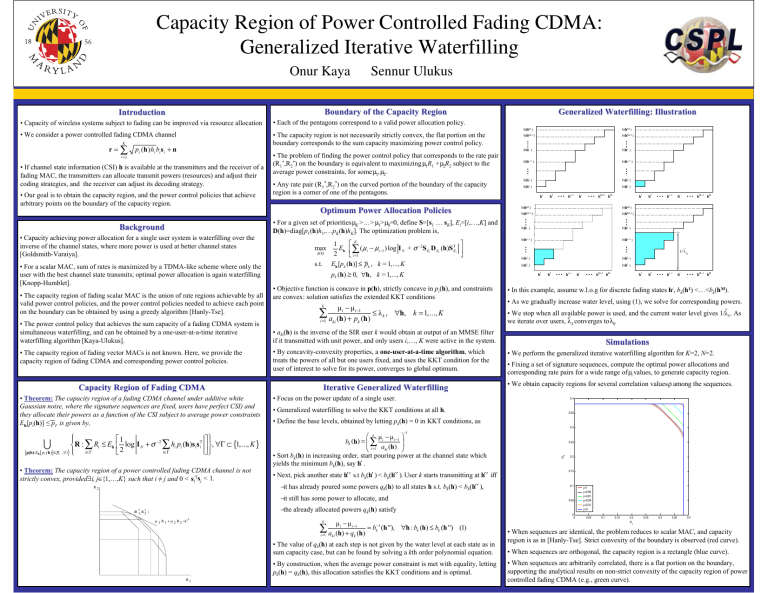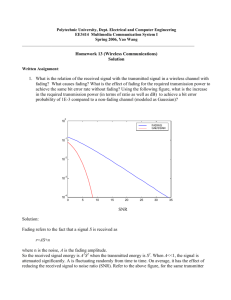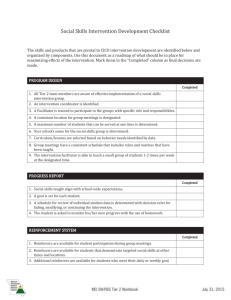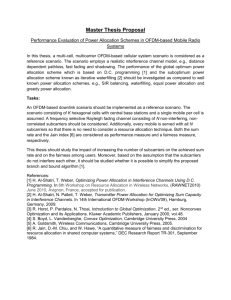Capacity Region of Power Controlled Fading CDMA: Generalized Iterative Waterfilling
advertisement

Capacity Region of Power Controlled Fading CDMA:
Generalized Iterative Waterfilling
Onur Kaya
Sennur Ulukus
Boundary of the Capacity Region
Introduction
• We consider a power controlled fading CDMA channel
• The capacity region is not necessarily strictly convex, the flat portion on the
boundary corresponds to the sum capacity maximizing power control policy.
Optimum Power Allocation Policies
• The capacity region of fading vector MACs is not known. Here, we provide the
capacity region of fading CDMA and corresponding power control policies.
Capacity Region of Fading CDMA
• Theorem: The capacity region of a fading CDMA channel under additive white
Gaussian noise, where the signature sequences are fixed, users have perfect CSI) and
they allocate their powers as a function of the CSI subject to average power constraints
Eh[pi(h)] ≤ pi, is given by,
∪
{p(h):Eh [ pi ( h )]≤ pi
⎧⎪
⎡1
−2
T
⎨R : ∑ Ri ≤ Eh ⎢ log I N + σ ∑ hi pi (h)si s i
i∈Γ
⎪ i∈Γ
,∀ i} ⎩
⎣2
⎤ ⎫⎪
⎥ ⎬, ∀Γ ⊂ {1,..., K }
⎦ ⎭⎪
• Theorem: The capacity region of a power controlled fading CDMA channel is not
strictly convex, provided∃i, j∈{1,…,K} such that i ≠ j and 0 < siTsj < 1.
R2
pk (h) ≥ 0, ∀h, k = 1,..., K
• Objective function is concave in p(h), strictly concave in pi(h), and constraints
are convex: solution satisfies the extended KKT conditions
k
µ i − µ i −1
≤ λ k , ∀h, k = 1,..., K
ki (h ) + pk (h )
∑a
i =1
• By concavity-convexity properties, a one-user-at-a-time algorithm, which
treats the powers of all but one users fixed, and uses the KKT condition for the
user of interest to solve for its power, converges to global optimum.
Iterative Generalized Waterfilling
ht−1
ht
...
hM−1 hM
h1
b(hM )
b(hM−1 )
h2
...
ht−1
ht
...
hM−1 hM
b(hM )
b(hM−1 )
b(ht )
b(ht )
b(ht−1 )
b(ht−1 )
b(h2 )
∼
1/ λ k
b(h2 )
b(h1 )
b(h1 )
h1
h2
...
ht−1
ht
...
hM−1 hM
h1
h2
...
ht−1
ht
...
hM−1 hM
• In this example, assume w.l.o.g for discrete fading states hi, bk(h1) <…<bk(hM).
• As we gradually increase water level, using (1), we solve for corresponding powers.
• We stop when all available power is used, and the current water level gives 1/λ k . As
we iterate over users, λ k converges to λk.
Simulations
• We perform the generalized iterative waterfilling algorithm for K=2, N=2.
• Fixing a set of signature sequences, compute the optimal power allocations and
corresponding rate pairs for a wide range of µi values, to generate capacity region.
• We obtain capacity regions for several correlation values ρ among the sequences.
0.4
• Generalized waterfilling to solve the KKT conditions at all h.
0.35
• Define the base levels, obtained by letting pk(h) = 0 in KKT conditions, as
0.3
−1
⎛ k µ − µ i −1 ⎞
bk (h) = ⎜ ∑ i
⎟
⎝ i =1 aki (h) ⎠
• Sort bk(h) in increasing order, start pouring power at the channel state which
yields the minimum bk(h), say h′ .
• Next, pick another state h′′ s.t bk(h′ ) < bk(h′′ ). User k starts transmitting at h′′ iff
−it has already poured some powers qk(h) to all states h s.t. bk(h) < bk(h′′ ),
µ i − µ i −1
= bk−1 (h'' ), ∀h : bk (h) ≤ bk (h'' ) (1)
∑
i =1 aki (h ) + qk (h )
k
• The value of qk(h) at each step is not given by the water level at each state as in
sum capacity case, but can be found by solving a kth order polynomial equation.
• By construction, when the average power constraint is met with equality, letting
pk(h) = qk(h), this allocation satisfies the KKT conditions and is optimal.
R1
...
• Focus on the power update of a single user.
−the already allocated powers qk(h) satisfy
µ 1 R 1 + µ 2 R 2 =C*
h2
• aki(h) is the inverse of the SIR user k would obtain at output of an MMSE filter
if it transmitted with unit power, and only users i,…, K were active in the system.
−it still has some power to allocate, and
* R* )
(R 1,
2
b(h1 )
h1
...
• The power control policy that achieves the sum capacity of a fading CDMA system is
simultaneous waterfilling, and can be obtained by a one-user-at-a-time iterative
waterfilling algorithm [Kaya-Ulukus].
s.t.
b(h2 )
b(h1 )
...
• The capacity region of fading scalar MAC is the union of rate regions achievable by all
valid power control policies, and the power control policies needed to achieve each point
on the boundary can be obtained by using a greedy algorithm [Hanly-Tse].
p(h)
1
⎡K
⎤
Eh ⎢ ∑ ( µi − µi −1 ) log I N + σ −2S Ei D Ei (h)S TEi ⎥
2
⎣ i =1
⎦
Eh [pk (h)] ≤ pk , k = 1,..., K
b(h2 )
...
• For a scalar MAC, sum of rates is maximized by a TDMA-like scheme where only the
user with the best channel state transmits; optimal power allocation is again waterfilling
[Knopp-Humblet].
max
b(ht−1 )
...
Background
• Capacity achieving power allocation for a single user system is waterfilling over the
inverse of the channel states, where more power is used at better channel states
[Goldsmith-Varaiya].
• For a given set of priorities µK >…> µ1> µ0=0, define S=[s1 … sK], Ei=[i,…,K] and
D(h)=diag[p1(h)h1,…pK(h)hK]. The optimization problem is,
b(ht )
b(ht−1 )
...
• Our goal is to obtain the capacity region, and the power control policies that achieve
arbitrary points on the boundary of the capacity region.
• Any rate pair (R1*,R2*) on the curved portion of the boundary of the capacity
region is a corner of one of the pentagons.
b(ht )
...
• If channel state information (CSI) h is available at the transmitters and the receiver of a
fading MAC, the transmitters can allocate transmit powers (resources) and adjust their
coding strategies, and the receiver can adjust its decoding strategy.
• The problem of finding the power control policy that corresponds to the rate pair
(R1*,R2*) on the boundary is equivalent to maximizing µ1R1 + µ2R2 subject to the
average power constraints, for some µ1, µ2.
b(hM )
b(hM−1 )
0.25
2
pi (h ) hi bi s i + n
i =1
b(hM )
b(hM−1 )
R
K
r=∑
Generalized Waterfilling:
Waterfilling: Illustration
...
• Each of the pentagons correspond to a valid power allocation policy.
...
• Capacity of wireless systems subject to fading can be improved via resource allocation
0.2
0.15
0.1
ρ=1
ρ=0.95
ρ=0.81
ρ=0.59
ρ=0.31
ρ=0
0.05
0
0
0.05
0.1
0.15
0.2
R1
0.25
0.3
0.35
0.4
• When sequences are identical, the problem reduces to scalar MAC, and capacity
region is as in [Hanly-Tse]. Strict convexity of the boundary is observed (red curve).
• When sequences are orthogonal, the capacity region is a rectangle (blue curve).
• When sequences are arbitrarily correlated, there is a flat portion on the boundary,
supporting the analytical results on non-strict convexity of the capacity region of power
controlled fading CDMA (e.g., green curve).




